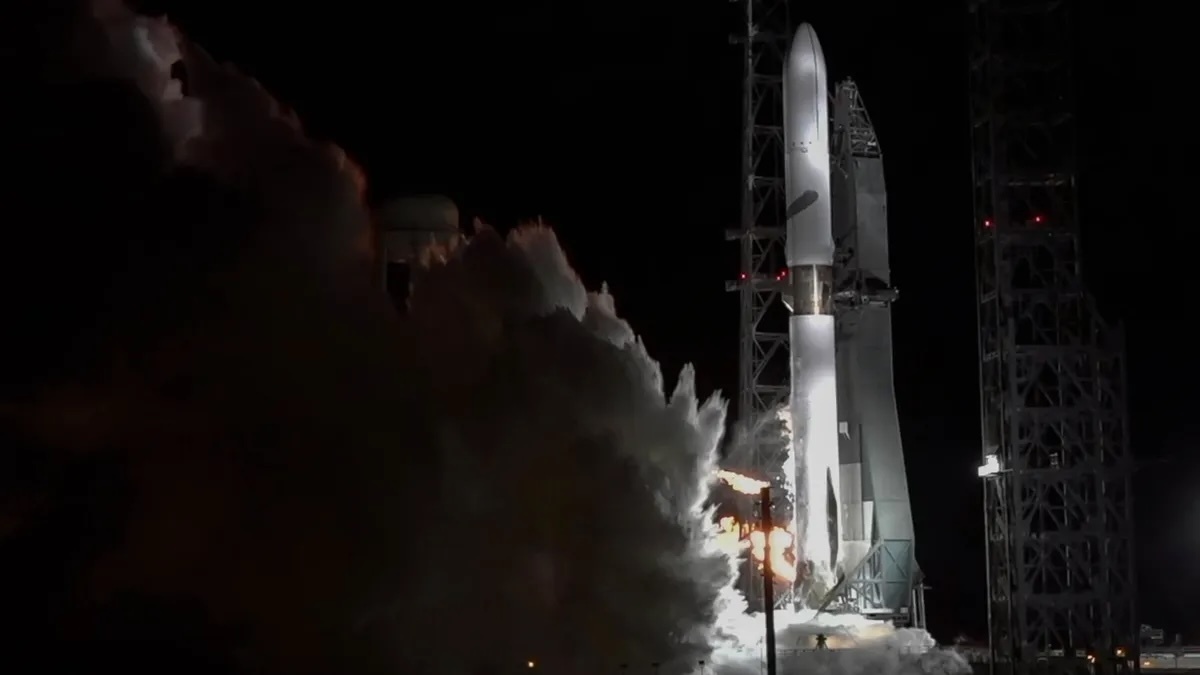19.08.2024
Rocket Lab’s Mars-bound twin satellites – Blue and Gold – hit the road ahead of Blue Origin launc
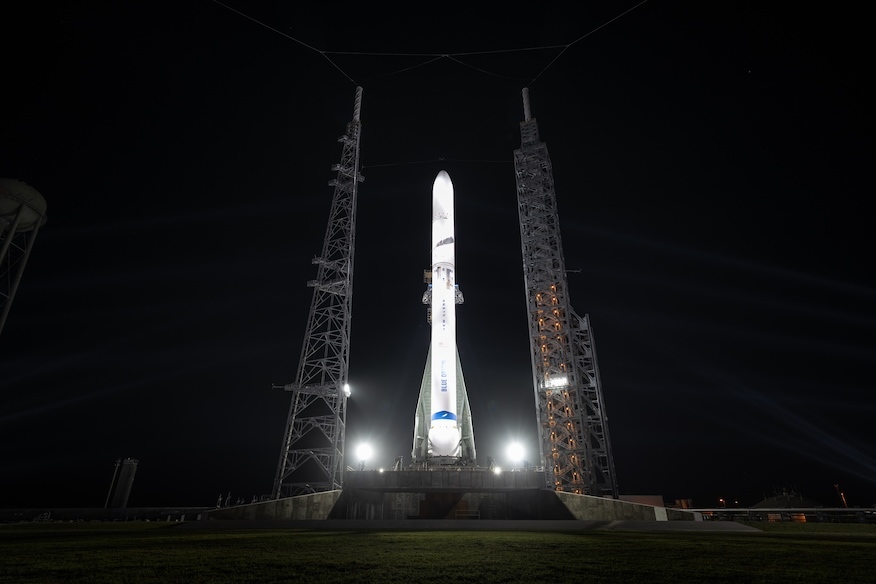
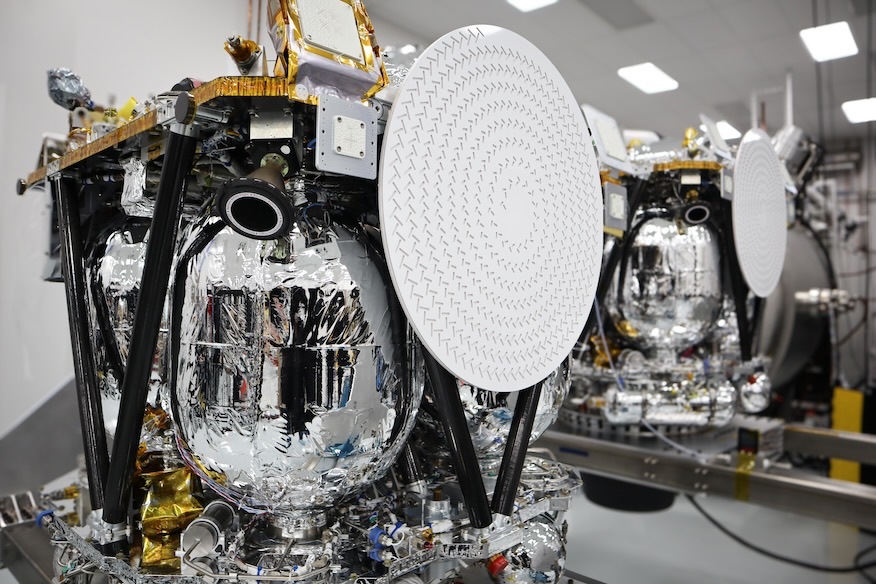
Rocket Lab is gearing up for its first mission to another planet. In the fall, two of its spacecraft will hitch a ride onboard a Blue Origin New Glenn rocket to begin their 11-month trek to Mars.
But before that happens, the twin spacecraft – named Blue and Gold – left Rocket Lab’s spacecraft manufacturing facility in Long Beach, California, and hit the road on Thursday to begin the journey to Florida’s Space Coast.
The duo will support NASA’s Escape and Plasma Acceleration and Dynamics Explorers (EscaPADE) mission, which the agency describes as the “first multi-spacecraft orbital science mission to the Red Planet.” The mission is set to launch no earlier than September 2024 on the inaugural New Glenn flight.
Last week, Christophe Mandy, the lead systems engineer on EscaPADE, led a media tour of the Long Beach site, showing off different parts of the space and the satellites themselves. He noted that the University of California, Berkeley’s Space Science Lab (SSL) is responsible for the science payloads onboard.

“It is being built by a lab that primarily does heliophysics. So, they study the interactions between what the Sun does and the rest of the solar system,” Mandy said. “In this specific case, they want to look at the interactions between the solar wind and the Martian atmosphere.
“They are looking for two different things. They’re looking for a phenomenon called ‘sputtering,’ which is where you have the billiard ball effect of a particle coming from the Sun, hitting a particle that’s at Mars and it goes away. The other type of interaction is called ‘ion escape,’ which is where that particle from the Sun comes and has a field, an electric field, typically. The electric field then steals an electric field on another particle, which then gets kicked off.”
Mandy said learning more about these effects will give scientists a better understanding of how the Martian atmosphere possibly evolved over time to make it uninhabitable and incapable of sustaining liquid water on its surface. It picks up the mission begun by NASA’s MAVEN (Mars Atmosphere and Volatile EvolutioN) mission, which launched back in 2013, but consisted of just one spacecraft.
Each of the EscaPADE spacecraft will use a suite of three main science instruments to search for these answers during their 11-month science mission:
- EMAG (Escapade MAGnetometer)
- EESA (Escapade ElectroStatic Analyzers)
- ELP (Escapade Langmuir Probe)

Building and budgeting for Mars
The EscaPADE satellites are being built as a part of NASA’s SIMPLEx (Small, Innovative Missions for PLanetary Exploration) program. The mission was selected by NASA in 2019 along with two other missions, each of which were given a cap of $55 million. For contrast, the MAVEN mission cost $671 million.
Originally, Mandy said the contract for the satellites went to a company called Tyvak International and the mission was manifested as part of NASA’s Psyche mission. That changed in 2020 when the agency decided to switch the Psyche mission from the expendable version of a Falcon 9 rocket to a Falcon Heavy, which ultimately changed that mission’s trajectory, according to Space News.
“This trajectory is not optimal for a mission with the goal of Mars capture and orbit, as EscaPADE is required to do, and would have required EscaPADE into an extended cruise phase to get into its correct orbit,” a NASA spokesperson told Space News at the time.
That meant that EscaPADE was de-manifested from the Psyche mission and NASA began searching for another launch option. Meanwhile, U.C. Berkeley was given an additional $1.8 million and nine more months to redesign the mission to be as flexible as possible in terms of launch vehicle options.
The University awarded a contract to build the spacecraft to Rocket Lab in November 2020 and in August 2021, a target launch date was set for October 2024.
“The payload on this spacecraft, the instrument set, is eight kilos. The entire spacecraft together is 525, so we’re sending 516 kilos of other stuff in order to get the eight kilos to Mars and that’s primarily because it’s really difficult to get from Earth orbit to Mars,” Mandy said. “The reason we’re going from Earth orbit to Mars is because we wanted to allow NASA to have as wide a range of possible launch options. Which, by the way, I think is a very cool achievement.”
Because the mission had a goal of launching by 2024 to capitalize on the optimal planetary launch window, that didn’t leave Rocket Lab with much time to work.
“The typical timeline for a Mars mission is a decade. Big missions like [Mars Sample Return], MSR started in 2002, so it’s already been over two decades. That’s the normal pace for an interplanetary mission,” Mandy said. “We had three-and-a-half years for everything.”
Mandy said everything about the design and execution of the two spacecraft was meant to stay within their means for both budget and time. He said the goal was creating “uncompromising efficiency.”
“There’s really nothing on the satellite that’s extraneous or complicated or unneeded,” Mandy said. “We typically push the capabilities of the technical side in order to find some really good synergies.”
Mandy said Rocket Lab built the majority of these spacecraft, including most of the avionics boxes as well as the multi-layer insulation (MLI), the radios, the star trackers and the solar panels. He said the propellant tanks had the longest lead time for manufacturing and were the last pieces of the spacecraft to arrive, on July 8, 2024.
The science instruments from U.C. Berkeley sit on the tops of these two-deck spacecraft. The items that generate heat, like the avionics and the batteries, are on the top deck to be cooled. Meanwhile, the bottom deck has all the fluid lines and the propellant tanks, which needs to stay warm.
Mandy said the two-deck structure made of a carbon composite material allowed them to shift more of the mass available from the structure to the other components. He said that’s a big shift from typical industry models.
“The typical number that you give is the primary structure, the main structure, should be on the order of 20 to 25 percent of the mass of the spacecraft. When we do it our way, ours is 11 percent,” Mandy said. “Pushing composites to extremes allows us to do that.”

The basic structure for EscaPADE stems from Rocket Lab’s Explorer satellite bus. It’s one of four in its spacecraft product line, alongside Lightning, Pioneer and Photon. The selection of any given satellite bus is driven by the mission’s needed capabilities.
“The Explorer product line, which would include the mission we sent to the Moon on Capstone, or EscaPADE, have a very, very high mass fraction that is fuel. In the case of EscaPADE, it’s almost 70 percent, which is an enormous number,” Mandy said. “So, if you are the type of mission that needs a lot of delta-v, you’ll probably go for Explorer.”
The main propulsion engine is the S400-12 Biprop Thruster from Arianespace, which uses a combination of monomethylhydrazine (MMH) and dinitrogen tetroxide (NTO). Mandy said they weighed a number of factors when it came to choosing which components to build and which to procure, like the engines.
“We looked at all the different options for engines that could get us [to Mars]. Rocket Lab has its own engines. We are more interested in mission success than anything else,” Mandy said. “There are these high heritage, very stable, long-duration mission engines that came out of other companies and we just picked one of those.”
Journey to Mars
Once the spacecraft complete their journey to Florida, they still have a notable, metaphorical road ahead before they’re ready for launch. Mandy said Blue and Gold will go through 21 days worth of processing, which includes another complete performance test.
After that, he and his team will take off all of the ‘remove before flight’ covers that are protecting various pieces of the spacecraft. They also need to enable and disable a variety of plugs before they get into fueling the spacecraft.
“There are four nitrogen tanks on the bottom. Those are our attitude control system tanks. Those have to be filled with nitrogen,” Mandy said. “There are two pressure tanks at the top with helium and then there’s the actual fueling itself. And once all of that is done, we’re ready.”

The twin spacecraft will then be mated to the payload adapter for Blue Origin’s New Glenn rocket ahead of its inaugural launch. Mandy said it has been an interesting process to work with a new rocket.
“It’s a new launch vehicle, which meant that the set of requirements that they had wasn’t fully defined from the beginning. And it was a process for us to work with Blue Origin and NASA LSP (Launch Services Program) as well as the program side, so NASA, Goddard and Berkeley, in order to nail things down,” he said. “Once you’re a company that has launched many, many launch vehicles, then you’ve got those well-defined, fully specked out user’s guides and Blue Origin just doesn’t have one yet, but they’re going to get there.”
The spacecraft will take roughly 11 months post-launch to make the journey to Mars. There are about seven burns leading up to what Mandy said the most important point to reach in the mission: the Mars orbit insertion burn, which will last about 700 seconds.
“Aside from being the one, critical burn, it is definitely the pucker part because once you’ve made it through MOI, we’ve got spare mass and margin on everything across the board,” Mandy said. “And gravity [is] on your side.”
Quelle: SN
----
Update: 20.08.2024
.
Rocket Lab Prepares Twin Satellites for NASA Mars Mission Launch
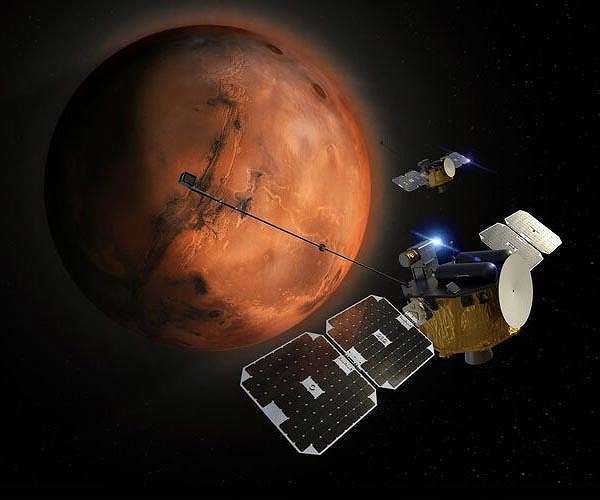
Rocket Lab USA, Inc. (Nasdaq: RKLB) has successfully packed and shipped two spacecraft bound for Mars to Cape Canaveral, FL, where they will undergo final preparations for launch. These twin spacecraft, part of the Escape and Plasma Acceleration and Dynamics Explorers (ESCAPADE) mission, were developed by Rocket Lab for the University of California Berkeley's Space Science Laboratory and NASA.
Known as Blue and Gold, the spacecraft recently completed their assembly, integration, and testing phases at Rocket Lab's Spacecraft Production Complex in Long Beach, California. Following these milestones, the team completed final closeout procedures, including the installation of solar arrays and multi-layer insulation blankets, before shipping the spacecraft to Florida.
Upon reaching NASA's Kennedy Space Center (KSC) Launch Complex, Rocket Lab's team will transfer the spacecraft to a cleanroom for detailed inspections and post-transport tests. After verifying their condition, the spacecraft will be prepared for fueling ahead of their launch aboard Blue Origin's New Glenn rocket.
"We've already been to the Moon for NASA, so we're excited to build on that and send Rocket Lab technology deeper into the solar system, this time to the Red Planet," said Rocket Lab founder and CEO Sir Peter Beck.
"Our Space Systems team has built a beautiful and highly capable pair of spacecraft to help NASA and the University of California Berkeley further humanity's understanding of Mars. We couldn't be prouder to be an ESCAPADE mission partner enabling science and exploration missions beyond our planet. After a meticulous but speedy build and test phase, we're excited to have Blue and Gold on their way to the Cape and a step closer to Mars."
"The successful delivery of the spacecraft to Kennedy Space Center marks a significant milestone and the culmination of over three years of dedicated teamwork from individuals across the project, especially our partners at Rocket Lab," said Rob Lillis, ESCAPADE Principal Investigator and Associate Director for Planetary Science at the UC Berkeley Space Sciences Laboratory.
"Interplanetary spacecraft must be much more resilient than earth satellites, and developing not one, but two of these probes almost from scratch was no small feat. Time and again, Rocket Lab's agility and tireless efforts have impressed me, exemplified by their frequent 'hero mode' (a saying we have on the project) to troubleshoot and keep the project on course. We couldn't ask for better partners in this endeavor. Now, we're thrilled to embark on this first step of our journey to Mars!"
Once in space, the ESCAPADE mission will gather data on plasma and magnetic fields surrounding Mars. This information will help scientists understand how processes strip atoms from the planet's magnetosphere and upper atmosphere, offering essential insights into Mars' climate history.
Quelle: SD
----
Update: 28.08.2024
.
NASA, Blue Origin Invite Media to New Glenn Launch of Mars Mission
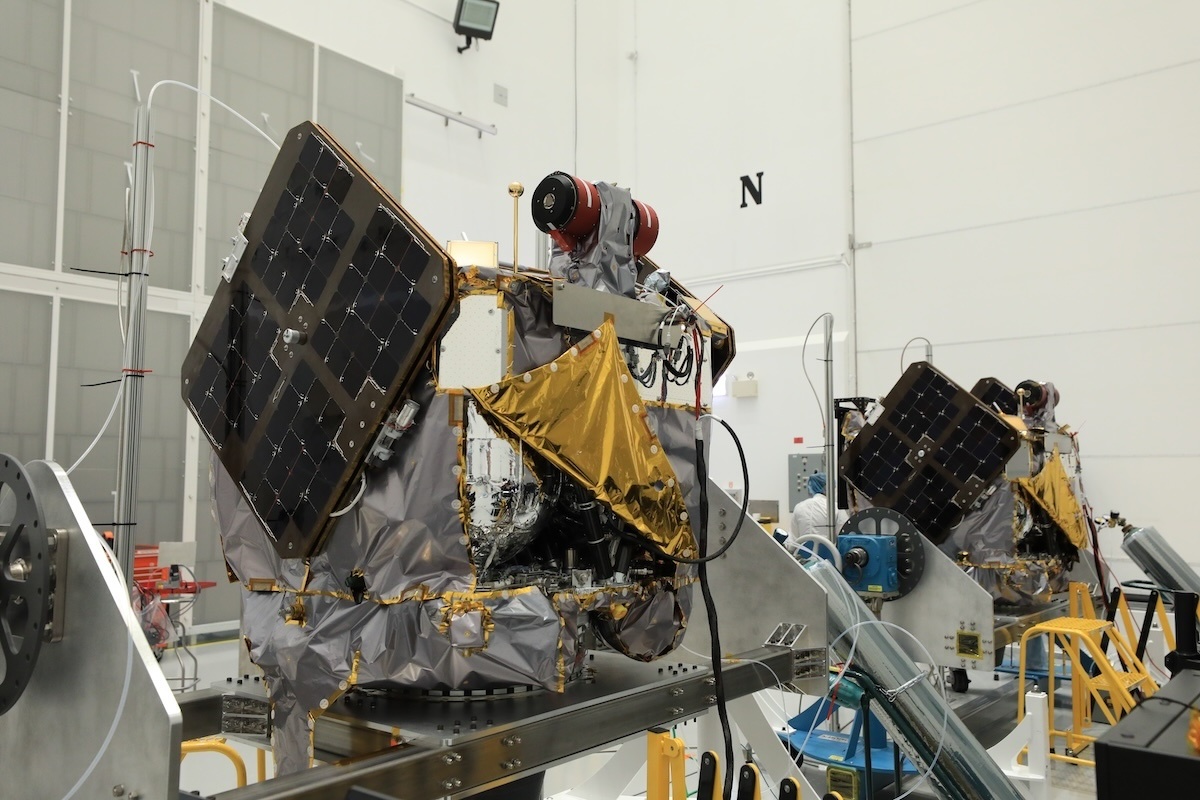
NASA and Blue Origin are preparing for the agency’s ESCAPADE (Escape and Plasma Acceleration and Dynamics Explorers) mission, which begins on the inaugural launch of the company’s New Glenn rocket. The mission will study the solar wind’s interaction with the magnetosphere on Mars.
Blue Origin is targeting no earlier than Sunday, Oct. 13, for the launch of New Glenn-1 from Space Launch Complex 36 at Cape Canaveral Space Force Station in Florida.
Media interested in covering ESCAPADE launch activities for both NASA and Blue Origin must apply for media credentials. Deadlines for accreditation are as follows:
- U.S. media and U.S. citizens representing international media must apply by 5 p.m. EDT on Monday, Sept. 30.
- International media without U.S. citizenship must apply by 5 p.m. on Tuesday, Sept. 10.
Media accreditation requests should be submitted online at:
A copy of NASA’s media accreditation policy is available online. For questions about accreditation, please email: ksc-media-accreditat@mail.nasa.gov. For other mission questions, please contact NASA Kennedy’s newsroom: 321-867-2468.
The ESCAPADE mission will use two identical spacecraft to investigate how the solar wind interacts with the hybrid magnetosphere on Mars and how this interaction drives the planet’s atmospheric escape. The mission is funded by NASA’s Heliophysics Division and is part of the NASA Small Innovative Missions for Planetary Exploration program. The ESCAPADE mission is led by the University of California, Berkeley’s Space Sciences Laboratory, and the spacecraft is designed by Rocket Lab. The agency’s Launch Services Program, based at NASA Kennedy, secured the launch service under the VADR (Venture-class Acquisition of Dedicated and Rideshare) contract.
NASA will post updates on launch preparations for the twin Martian orbiters on the ESCAPADE blog.
Quelle: NASA
----
Update: 2.09.2024
.
Rocket Lab's Mars probes reach launch site ahead of 1st flight on Blue Origin New Glenn rocket
'Now, we're thrilled to embark on this first step of our journey to Mars!'
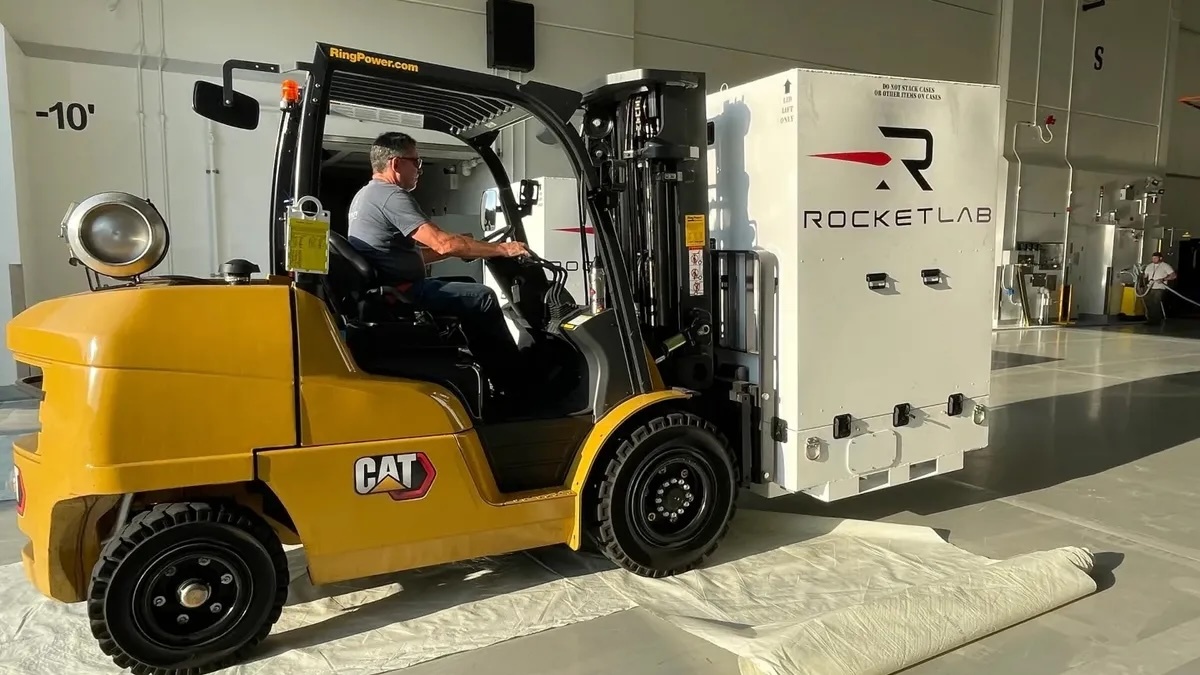
On Aug. 18, 2024, Rocket Lab delivered the two spacecraft for NASA’s ESCAPADE mission to the Astrotech Space Operations Facility in Titusville, Florida, in preparation for launch this fall. (Image credit: NASA/Norman Phelps)
Two Mars-bound smallsats that will fly on the highly anticipated debut of Blue Origin's New Glenn rocket have arrived at their launch site in Florida.
The satellite duo, known as ESCAPADE ("Escape and Plasma Acceleration and Dynamics Explorers"), are set to launch atop New Glenn no earlier than Oct. 13from Cape Canaveral Space Force Station in Florida. They'll arrive in Mars orbit in September 2025, on a NASA mission to study how incoming charged particles from the sun interact with and alter the planet's magnetic environment.
The two coordinated robotic explorers could paint a more detailed picture of how Mars' interaction with the solar wind influences the leaking of the planet's thin atmosphere, and how its climate evolved over time to lose what scientists think was once a plentiful reserve of liquid water on the surface.
On Aug. 18, the twin ESCAPADE spacecraft arrived at the Astrotech Space Operations Facility in Titusville, Florida, to prepare for launch. At the facility, which is owned by Lockheed Martin, teams will check various aspects of the satellites in a dedicated cleanroom, including their electrical circuits and potential leaks in their tanks before carrying out the final assembly.
The spacecraft will be fueled next month, NASA said in a recent statement.
"The successful delivery of the spacecraft marks a significant milestone and the culmination of over three years of dedicated teamwork from individuals across the project," ESCAPADE Principal Investigator Rob Lillis, of the University of California, Berkeley, said in the NASA statement. "Now, we're thrilled to embark on this first step of our journey to Mars!"
The two small satellites were built by California-based Rocket Lab and UC Berkeley, which is leading the mission and has dubbed the satellites "Blue" and "Gold" after the school's traditional colors. Each probe weighs under 198 pounds (90 kilograms) and carries three science instruments. The total cost for the mission is less than $80 million, according to the mission website.
The value of the launch contract that NASA signed with Blue Origin is $20 million, SpaceNews reported.
ESCAPADE is among a wave of low-cost, high-risk NASA missions to other planets, which otherwise typically demand over a decade of development and exceed $1 billion in costs. "Sending two spacecraft to Mars for the total cost of $80 million is just unheard of, but current NASA leadership is taking the risk," Lillis said in a previous press release. "Instead of spending $800 million for a 95% chance of success, can we spend $80 million for an 80% chance? This is what NASA is trying to find out with these missions, and we are lucky to be one of the guinea pigs."
The satellites were initially scheduled to piggyback on the same SpaceX Falcon Heavy rocket that would loft the Psyche asteroid mission in August 2022. They were removed, however, after delays to the Psyche mission resulted in a new trajectory that didn't support dropping ESCAPADE off at Mars. (Psyche ended up launching successfully in October 2023.) The satellite duo then became the primary payload onboard Blue Origin's first orbital rocket, New Glenn, which is a two-stage heavy-lift rocket named after NASA astronaut John Glenn, who in 1962 became the first American to circle Earth.
New Glenn is 322 feet (98 meters) tall, roughly the height of a 30-story building, and is capable of launching roughly 45 metric tons into low Earth orbit. Its maiden flight will come after more than a decade of development by Blue Origin, which was founded by Amazon CEO Jeff Bezos, and over three years later than the company hoped for.
Once the ESCAPADE satellites reach Mars in September 2025, "the mission team will need several months to configure their orbits for science observations," NASA said in the recent news release. Their orbit will be adjusted over several months such that by early 2026 they'll follow each other in a "string of pearls" formation, which will allow them to gather data on Mars' rapidly changing response to the solar wind.
They will later break into different orbits such that they can observe both the solar wind and Mars' upper atmosphere in real time, according to the space agency. The science mission is designed to last 11 months in Mars orbit, until March 2027.
Meanwhile, the New Glenn first stage is expected to return to Earth shortly after liftoff, demonstrating its reusability. Blue Origin has said that the first stage will operate like a commercial airliner but with cleaner fuel, leading to less waste and lower launch costs.
In recent weeks, portions of other New Glenn rockets scheduled for future flights have suffered damage, Bloomberg reported on Aug. 21. In one incident, the top of Blue Origin's second New Glenn rocket crumpled "like a crushed Coke can," partly due to an error by factory workers who had moved the section into a chilled storage hangar but didn't monitor the hardware afterward. In the second incident, a part of the third New Glenn rocket failed during stress testing and exploded inside a building.
No injuries were reported in either incident, according to Bloomberg, which first broke the news about the recent failures. The issues haven't affected New Glenn's planned debut launch in October, a Blue Origin spokesperson told GeekWire's Alan Boyle.
Quelle: SC
----
Update: 6.09.2024
.
Blue Origin droneship arrives in Port Canaveral ahead of New Glenn launch

Pulled by Blue Origin's support ship, Harvey Stone, a droneship like no other arrived in Port Canaveral Wednesday morning. What arrived can only be described as a floating first-stage rocket center − a "landing platform vessel" complete with buildings on the front and back which sported the words "Blue Origin" and "New Glenn".
Jacklyn is the name of this droneship. That also happens to be the name of the mother of Blue Origin founder, Jeff Bezos.
What Jacklyn's arrival at Port Canaveral means is that soon SpaceX will not be the only space company landing rockets on droneships in the Atlantic Ocean. Blue Origin has ambitious plans to do the same with the first stage of their New Glenn rocket.
New Glenn is expected to make its debut no earlier than October 13 from Cape Canaveral Space Force Station. The massive 320-foot-tall heavy-lift rocket will send NASA's ESCAPADE mission to Mars from Launch Complex 36 — where the space company has invested more than $1 billion on reconstruction work.
Blue Origin has been quietly working towards the October launch for most of the year. Back in February, Cape Canaveral saw New Glenn standing vertically on the launch pad. Blue Origin has also been spotted doing various other forms of testing, including recovering a mock-up of the New Glenn first-stage back in August.
Blue Origin has nearly perfected the landing of their single-stage suborbital (straight up and down) New Shepard rocket, which launches a capsule of six space tourists on a short spaceflight from West Texas.However, they have not yet attempted to do so with their multi-stage giant orbital New Glenn rocket. The rocket is named is named in honor of John Glenn, the first American to orbit the Earth.
According to Blue Origin, their New Glenn rocket's first stage, which will land on Jacklyn, will be able to be reused up to 25 times − which is comparable to SpaceX's Falcon 9, which has so far been proved reusable up to 22 times.
Currently, Blue Origin's customer flights for New Glenn include: NASA's ESCAPADE, Amazon Project Kuiper satellites, and TELESAT internet satellites.
Blue Origin rocket testing this week at Cape Canaveral
In a few days at Launch Complex 36, Blue Origin plans to test the BE-3U engine of its New Glenn rocket. According to Blue Origin, the extra power from the BE-38 engine will allow the upper or second stage to preform a wide range of different missions − such as send a NASA mission to Mars. No specific information on the testing was given.
Blue Origin describes the entire New Glenn flight sequence in this way: "New Glenn lifts off. Following separation, the first stage autonomously descends to a landing platform located 620 miles (1,000 km) downrange. The two BE-3Us ignite, propelling the second stage into space. The fairing separates, safely delivering the payloads into orbit."
With the targeted launch date just over a month away, Blue Origin keeps showing signs of pushing forward.
Quelle: Florida Today
----
Update: 24.09.2025
.
ESCAPADE (Escape and Plasma Acceleration and Dynamics Explorers)
NASA’s ESCAPADE Spacecraft Return to Florida to Prepare for Launch
NASA’s twin ESCAPADE (Escape and Plasma Acceleration and Dynamics Explorers) spacecraft are back in Florida in preparation for launch this fall.
The two spacecraft are destined to orbit Mars, where they will study the structure of the Martian magnetic field, how it interacts with space weather, and how this interaction drives the planet’s atmospheric escape. The information gained from the ESCAPADE spacecraft will enable us to better protect future human and robotic missions to the Red Planet.

The ESCAPADE spacecraft arrived at the Astrotech Space Operations Facility in Titusville, Florida, on Sept. 16 from Rocket Lab’s Spacecraft Production Complex and headquarters in Long Beach, California, where it was designed, built, and tested.
The spacecraft were previously in Florida in 2024, but had returned to California after NASA decided to stand down from a launch attempt last year.
Before propellant loading and vehicle integration, Rocket Lab engineers will complete inspections and functional tests in the Astrotech cleanroom.
Launch is scheduled to occur no earlier than this fall on Blue Origin’s New Glenn rocket.
The ESCAPADE mission is funded by NASA’s Heliophysics Division and is part of the NASA Small Innovative Missions for Planetary Exploration program. The mission is led by the University of California, Berkeley’s Space Sciences Laboratory, with key partners including Rocket Lab; NASA’s Goddard Space Flight Center in Greenbelt, Maryland; Embry Riddle Aeronautical University; and Advanced Space LLC. NASA’s Launch Services Program, based at Kennedy Space Center, secured the launch service with Blue Origin under the VADR (Venture-class Acquisition of Dedicated and Rideshare) contract.
Quelle: NASA
----
Update: 2.11.2025
.
Blue Origin fires up powerful New Glenn rocket ahead of NASA Mars mission launch

